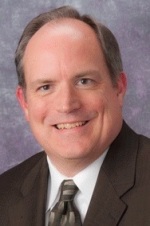
HTMs and OEMs discuss during
a breakfast panel how to establish
greater collaboration for servicing of
medical equipment
a breakfast panel how to establish
greater collaboration for servicing of
medical equipment
How can OEMs and in-house service teams work better together?
June 19, 2019
by John R. Fischer, Senior Reporter
AAMI Exchange attendees gathered early Sunday morning in the grand ballroom at the Cleveland Convention Center for coffee, breakfast and a panel discussion entitled HTM and OEMs: Best Practices for Building Strong Partnerships.
Hosted by HealthCare Business News, the event put equipment maintenance under the microscope and took aim at best practices and useful tips for ensuring the two different groups can work efficiently together in the interest of reducing costs while maximizing uptime.
“We all have single alignments, and we’re all trying to make sure we have the best outcome possible for patients. OEMs have that, as do you in the hospitals. That is the common goal,” said Dave Karchner, senior director of marketing, operating room, service, and government solutions at Draeger. “We also are all focused on how we look at value-based care versus fee for service care. Then it comes down to how we can reduce costs as much as possible while balancing and maximizing at all times. Those are the main differences we’re working through right now.”
The other speakers included Michael Dowd, director of bioengineering at Montefiore Medical Center; Joe Haduch, senior director of clinical engineering services at the UPMC; and Christine Lippiatt, service manager for Cleveland/Toledo at Philips North America.
According to all four of them, communication is the prime directive. By nurturing stronger bonds and open, candid relationships between hospitals and their manufacturer partners, each side can understand the other’s needs while also taking better advantage of the support each brings to the table.
Transparency is key
Sharing the in-house biomedical perspective, Dowd said one way OEMs can help is by increasing access to training and sources for servicing, repairing and maintaining equipment.
“Some of these things are common sense; but it’s been going on for many years, that there are some areas where we have issues getting service manuals," he said. "Another area is checklists. Having the OEM understand where our needs are and providing for them is really helpful to us.”
Karchner agreed, adding that the best way to facilitate such access is for providers to communicate their needs directly to the OEMs — not just at the time of purchase but when using the equipment too.
“Three, five, six years into use of the equipment, continue to provide feedback not only to your sales person but also to the product management team," he said. "We understand that providers have unique, individual needs. Communicate those needs to your OEM so we can work with you to make special arrangements, like a shared service offering, or even a tiered service where we provide parts proactively."
As tech evolves, so must partnerships
The discussion touched upon innovations, such as the use of predictive analytics for reducing the burden of preventative maintenance protocols. It also looked at whether or not the FDA could help standardize the OEM-HTM relationship.
Growing concern for the cybersecurity of medical devices was a topic that stirred particular interest among the panelists. Lippiatt described it as an area that is “ever evolving” between OEM and in-house HTM, and like other elements of these partnerships, they are often unique to individual organizations.
“We need to recognize what your concerns are and work together with you. That’s going to include, during the purchasing process, doing an assessment of your security needs, through the installation and even following up through the lifespan of the product," she said. "It involves setting up patches and making this accessible.”
Haduch agreed with that sentiment, adding that "OEMs need to provide HTM teams with easily accessible patch and/or update sites so [they] can monitor their current version of software against the most recently available software."
Defining value and packaging it into equipment purchases
While manufacturers and in-house service teams were in agreement throughout much of the panel, some fundamental challenges without easy answers were also addressed. For example, Haduch made the case that providers need to see greater profit derived from equipment investment, calling the existing business model "unsustainable" for the healthcare ecosystem.
"As operational margins shrink, capital dollars will become increasingly hard to come by," he said. "OEMs should deliver value-engineered equipment that will help boost provider margins through either significant and sustainable savings or increased revenues," said Haduch.
Without alternative purchase solutions based on defined outcome metrics, he suggested large capital equipment investments may someday become a thing of the past.
"OEMs will need to view equipment as a long term annuity that generates revenues based on positive contributions to providers' bottom line," said Haduch. "From an operational perspective, OEMs and HTMs need to quit playing the parts discount shell game and develop cost-plus models for parts purchases that share market volatility and lower total cost of ownership."
Moving from fee to value-based service can mean different things to different equipment stakeholders. Getting everyone on the same page is no small task, but open discussion is one of the best ways to figure out where the challenges are, and how to address them. Ensuring quality servicing and maintenance to equipment in an affordable and transparent way means patients receive the best care possible.
Hosted by HealthCare Business News, the event put equipment maintenance under the microscope and took aim at best practices and useful tips for ensuring the two different groups can work efficiently together in the interest of reducing costs while maximizing uptime.
“We all have single alignments, and we’re all trying to make sure we have the best outcome possible for patients. OEMs have that, as do you in the hospitals. That is the common goal,” said Dave Karchner, senior director of marketing, operating room, service, and government solutions at Draeger. “We also are all focused on how we look at value-based care versus fee for service care. Then it comes down to how we can reduce costs as much as possible while balancing and maximizing at all times. Those are the main differences we’re working through right now.”
The other speakers included Michael Dowd, director of bioengineering at Montefiore Medical Center; Joe Haduch, senior director of clinical engineering services at the UPMC; and Christine Lippiatt, service manager for Cleveland/Toledo at Philips North America.
According to all four of them, communication is the prime directive. By nurturing stronger bonds and open, candid relationships between hospitals and their manufacturer partners, each side can understand the other’s needs while also taking better advantage of the support each brings to the table.
Transparency is key
Sharing the in-house biomedical perspective, Dowd said one way OEMs can help is by increasing access to training and sources for servicing, repairing and maintaining equipment.
“Some of these things are common sense; but it’s been going on for many years, that there are some areas where we have issues getting service manuals," he said. "Another area is checklists. Having the OEM understand where our needs are and providing for them is really helpful to us.”
Karchner agreed, adding that the best way to facilitate such access is for providers to communicate their needs directly to the OEMs — not just at the time of purchase but when using the equipment too.
“Three, five, six years into use of the equipment, continue to provide feedback not only to your sales person but also to the product management team," he said. "We understand that providers have unique, individual needs. Communicate those needs to your OEM so we can work with you to make special arrangements, like a shared service offering, or even a tiered service where we provide parts proactively."
As tech evolves, so must partnerships
The discussion touched upon innovations, such as the use of predictive analytics for reducing the burden of preventative maintenance protocols. It also looked at whether or not the FDA could help standardize the OEM-HTM relationship.
Growing concern for the cybersecurity of medical devices was a topic that stirred particular interest among the panelists. Lippiatt described it as an area that is “ever evolving” between OEM and in-house HTM, and like other elements of these partnerships, they are often unique to individual organizations.
“We need to recognize what your concerns are and work together with you. That’s going to include, during the purchasing process, doing an assessment of your security needs, through the installation and even following up through the lifespan of the product," she said. "It involves setting up patches and making this accessible.”
Haduch agreed with that sentiment, adding that "OEMs need to provide HTM teams with easily accessible patch and/or update sites so [they] can monitor their current version of software against the most recently available software."
Defining value and packaging it into equipment purchases
While manufacturers and in-house service teams were in agreement throughout much of the panel, some fundamental challenges without easy answers were also addressed. For example, Haduch made the case that providers need to see greater profit derived from equipment investment, calling the existing business model "unsustainable" for the healthcare ecosystem.
"As operational margins shrink, capital dollars will become increasingly hard to come by," he said. "OEMs should deliver value-engineered equipment that will help boost provider margins through either significant and sustainable savings or increased revenues," said Haduch.
Without alternative purchase solutions based on defined outcome metrics, he suggested large capital equipment investments may someday become a thing of the past.
"OEMs will need to view equipment as a long term annuity that generates revenues based on positive contributions to providers' bottom line," said Haduch. "From an operational perspective, OEMs and HTMs need to quit playing the parts discount shell game and develop cost-plus models for parts purchases that share market volatility and lower total cost of ownership."
Moving from fee to value-based service can mean different things to different equipment stakeholders. Getting everyone on the same page is no small task, but open discussion is one of the best ways to figure out where the challenges are, and how to address them. Ensuring quality servicing and maintenance to equipment in an affordable and transparent way means patients receive the best care possible.



